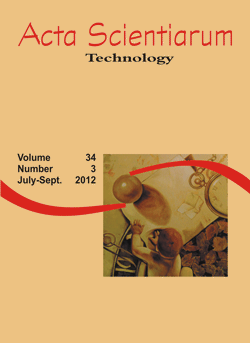<b>Kraft pulping and ECF bleaching of <i>Eucalyptus</i> globulus pretreated by the white-rot fungus <i>Ceriporiopsis subvermispora</i></b></b> - doi: 10.4025/actascitechnol.v34i3.12410
DOI:
https://doi.org/10.4025/actascitechnol.v34i3.12410Palavras-chave:
biopulping, Ceriporiopsis subvermispora, Eucalyptus globulus, kraft pulpingResumo
Eucalyptus globulus wood chips were decayed by the lignin-degrading fungus Ceriporiopsis subvermispora as a pretreatment step before kraft pulping. Weight and component losses of wood after the biotreatment were the following: weight (5%), glucans (1.5%), xylans (4.3%), lignin (5.7%) and extractives (57.5%). The residual amount of lignin (expressed by the kappa number) in pulps from biotreated wood chips was lower than that of pulps from the undecayed control. Depending on the delignification degree, kraft biopulps presented similar or up to 4% increase in pulp yield and 20% less hexenuronic acids (HexA) than control pulps. The extended delignification with O2 decreases approximately 50% of the kappa number of the pulps and increases brightness, but had no effect in HexA reduction. The bleaching steps with chlorine dioxide (D0ED1 sequence) decreased the kappa number up to 97%, increased pulp brightness up to 84% ISO and decreased HexA amount up to 91%. The use of C. subvermispora in biopulping of E. globulus generated important benefits during the production of kraft pulps that are reflected in a high pulp yield, low residual lignin content, low HexA amount, high brightness and viscosity of the biopulps as compared with pulps produced from untreated wood chips.
Downloads
Downloads
Publicado
Como Citar
Edição
Seção
Licença
DECLARAÇíO DE ORIGINALIDADE E DIREITOS AUTORAIS
Declaro que o presente artigo é original, não tendo sido submetido í publicação em qualquer outro periódico nacional ou internacional, quer seja em parte ou em sua totalidade.
Os direitos autorais pertencem exclusivamente aos autores. Os direitos de licenciamento utilizados pelo periódico é a licença Creative Commons Attribution 4.0 (CC BY 4.0): são permitidos o compartilhamento (cópia e distribuição do material em qualqer meio ou formato) e adaptação (remix, transformação e criação de material a partir do conteúdo assim licenciado para quaisquer fins, inclusive comerciais.
Recomenda-se a leitura desse link para maiores informações sobre o tema: fornecimento de créditos e referências de forma correta, entre outros detalhes cruciais para uso adequado do material licenciado.















